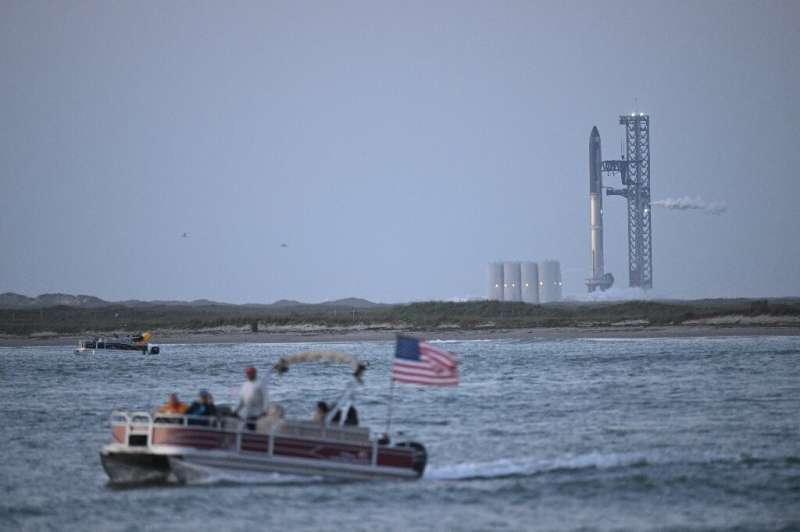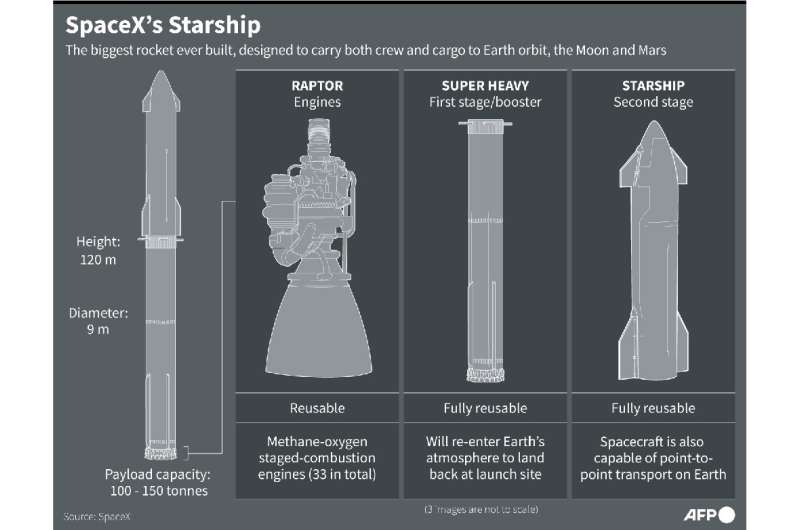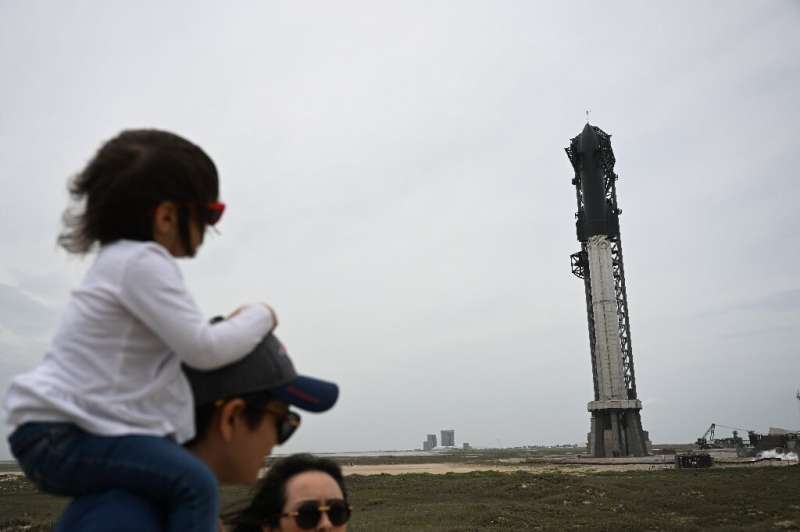This article has been reviewed according to Science X's editorial process and policies. Editors have highlighted the following attributes while ensuring the content's credibility:
fact-checked
reputable news agency
proofread
SpaceX reschedules Starship test flight for Thursday

SpaceX has rescheduled for Thursday the first test flight of Starship, the most powerful rocket ever built, designed to send astronauts to the Moon, Mars and beyond, after a technical glitch forced a halt to the countdown.
A planned liftoff Monday of the gigantic rocket was called off less than 10 minutes ahead of the scheduled launch because of a pressurization issue in the first-stage booster, SpaceX said.
The private space company continued with the countdown in what it called a "wet dress rehearsal," stopping the clock with 10 seconds to go, just before the massive engines on the booster were to have been ignited.
SpaceX founder Elon Musk said a frozen pressure valve forced a scrub of the launch, which had been planned for 8:20 am Central Time (1320 GMT) from Starbase, the SpaceX spaceport in Boca Chica, Texas.
"Learned a lot today, now offloading propellant, retrying in a few day," Musk tweeted.
Before announcing Thursday as the new target for liftoff, SpaceX had said the inaugural flight would be delayed for at least 48 hours to recycle the liquid methane and liquid oxygen that fuels the rocket.
The new launch window opens Thursday at 8:28 am Central Time (1328 GMT) and lasts 62 minutes, SpaceX said on Twitter.
The US space agency NASA has picked the Starship spacecraft to ferry astronauts to the Moon in late 2025—a mission known as Artemis III—for the first time since the Apollo program ended in 1972.

Starship consists of a 164-foot (50-meter) tall spacecraft designed to carry crew and cargo that sits atop a 230-foot tall first-stage Super Heavy booster rocket.
SpaceX conducted a successful test-firing of the 33 Raptor engines on the first-stage booster in February but the Starship spacecraft and the Super Heavy rocket have never flown together.
The integrated test flight is intended to assess their performance in combination.
Musk had warned ahead of the launch that a delay was likely.
"It's a very risky flight," he said earlier. "It's the first launch of a very complicated, gigantic rocket.
"There's a million ways this rocket could fail," Musk said. "We're going to be very careful and if we see anything that gives us concern, we'll postpone."
'Multi-planet species'
NASA will take astronauts to lunar orbit itself in November 2024 using its own heavy rocket called the Space Launch System (SLS), which has been in development for more than a decade.

Starship is both bigger and more powerful than SLS and capable of lifting a payload of more than 100 metric tonnes into orbit.
It generates 17 million pounds of thrust, more than twice that of the Saturn V rockets used to send Apollo astronauts to the Moon.
The plan for the integrated test flight is for the Super Heavy booster to separate from Starship about three minutes after launch and splash down in the Gulf of Mexico.
Starship, which has six engines of its own, will continue to an altitude of nearly 150 miles, completing a near-circle of the Earth before splashing down in the Pacific Ocean about 90 minutes after launch.
"If it gets to orbit, that's a massive success," Musk said.
"If we get far enough away from the launchpad before something goes wrong then I think I would consider that to be a success," he said. "Just don't blow up the launchpad."
SpaceX foresees eventually putting a Starship into orbit, and then refueling it with another Starship so it can continue on a journey to Mars or beyond.

Musk said the goal is to make Starship reusable and bring down the price to a few million dollars per flight.
"In the long run—long run meaning, I don't know, two or three years—we should achieve full and rapid reusability," he said.
The eventual objective is to establish bases on the Moon and Mars and put humans on the "path to being a multi-planet civilization," Musk said.
"We are at this brief moment in civilization where it is possible to become a multi-planet species," he said. "That's our goal. I think we've got a chance."
© 2023 AFP



















